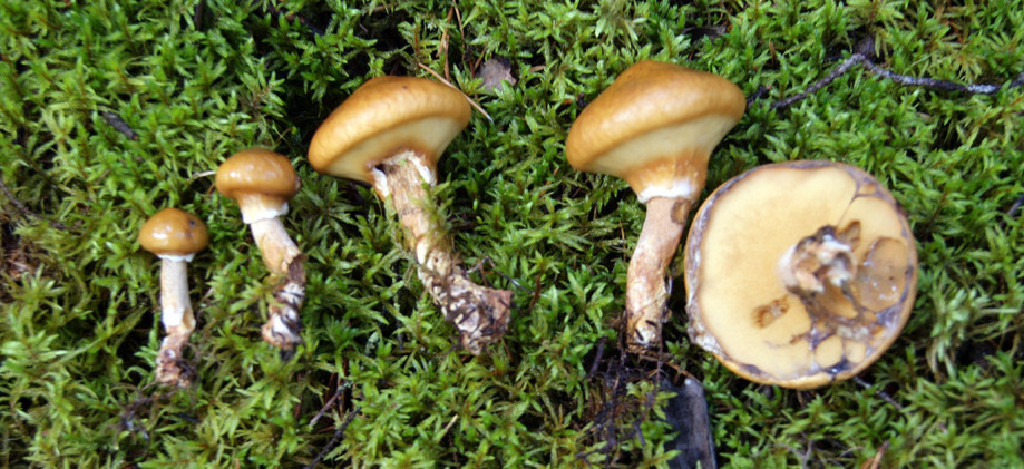What Is the Difference Between Slippery Jack and Jill?

In the enchanting realm of mycology, where the forest floor conceals hidden treasures and nature’s subtleties captivate the curious, two names—Slippery Jack and Jill—emerge as if from a whimsical nursery rhyme.
But make no mistake; these aren’t characters in a children’s tale. They are real, living entities in the fungal world, each with a story to tell and unique attributes that set them apart.
Imagine venturing into the woods, where the dappled sunlight filters through the leaves and a sense of wonder fills the air. Amidst the moss-covered logs and fallen leaves, you encounter mushrooms that bear these peculiar names. You may ask, “What distinguishes Slippery Jack from Jill, and why do they share such playful monikers?”
Join us on a journey through the captivating nuances of Slippery Jack and Jill, as we unveil their secrets and discover what sets these mushroom species apart in the captivating world of fungi.
Slippery Jack vs. Jill: An Overview

To grasp the unique attributes of Slippery Jack and Jill, it’s essential to start with a basic overview of each species. Below is a brief description of both, along with some key characteristics:
| Characteristic | Slippery Jack (Suillus luteus) | Jill (Suillus granulatus) |
| Cap Color | Chestnut-brown to yellowish-brown | Lighter shades, often pale yellow or brown |
| Cap Texture | Slimy when wet, drier when mature | Often dry and slightly scaly |
| Stem | Thick, with a prominent ring (annulus) | Slender, with a small or absent ring |
| Pores on Underside | Bright yellow to olive | Pale yellow, close-set |
| Edibility | Edible after thorough cooking | Generally considered inedible |
| Mycorrhizal Association | Forms symbiotic relationships with certain trees | Forms symbiotic associations with conifers |
| Distribution | Widespread in many regions | Primarily found in coniferous forests |
| Common Names | Slippery Jack, Butter Bolete, Pine Mushroom | Jill, Larch Bolete, Granulated Bolete |
Now, let’s delve deeper into these distinctions:
Cap Color and Texture
One of the most apparent differences between Slippery Jack and Jill lies in their cap characteristics. Slippery Jack, scientifically known as Suillus luteus, typically boasts a chestnut-brown to yellowish-brown cap.
As the name suggests, this cap can indeed become slippery when it’s wet, giving the mushroom its distinctive name. On the other hand, Jill, or Suillus granulatus, often has lighter shades for its cap, which can range from pale yellow to brown. Its cap is usually dry and may exhibit slight scaliness.
Stem and Ring (Annulus)
The stem of a mushroom can provide valuable clues for identification. Slippery Jack’s stem is thicker and features a prominent ring or annulus. This ring is a distinguishing feature that sets it apart from Jill. On the contrary, Jill’s stem is generally slender and lacks a prominent ring.
Pores on the Underside
To further differentiate between Slippery Jack and Jill, you can examine the pores on the underside of their caps. Slippery Jack’s pores typically appear bright yellow to olive, providing a vivid contrast to the cap’s color. Jill, in contrast, has pale yellow pores that are closely set, creating a different visual effect.
Edibility
While both Slippery Jack and Jill are part of the Suillus genus, their edibility differs significantly. Slippery Jack is considered edible, but it’s crucial to emphasize that it must be thoroughly cooked before consumption.
The slippery nature of its cap is due to a slimy layer that can be bitter and unpalatable when raw. On the other hand, Jill is generally regarded as inedible, mainly due to its tough and less appetizing qualities.
Mycorrhizal Association and Distribution
Understanding the relationship between these mushrooms and the trees they are associated with can be another way to distinguish them. Slippery Jack, Suillus luteus, forms mycorrhizal associations with various trees, including pines and other conifers.
This makes it widespread and adaptable, thriving in different regions. In contrast, Jill, or Suillus granulatus, primarily forms symbiotic relationships with conifers like larch trees. As a result, Jill is often found in coniferous forests.
Common Names
While the scientific names provide a clear distinction, common names can be equally illuminating. Slippery Jack goes by various names, including Butter Bolete and Pine Mushroom, reflecting its affinity for pine trees. Jill is known by names such as Larch Bolete and Granulated Bolete, emphasizing its connection with conifers.
Culinary Uses and Preparations of Slippery Jack and Jill Mushrooms
Slippery Jack and Jill mushrooms boast a rich history in culinary traditions, finding their way into a plethora of dishes across various cultures. From the rustic kitchens of Europe to the avant-garde culinary scenes, these mushrooms have been a staple ingredient for centuries.
In traditional cooking, they are often incorporated into hearty soups and stews, lending their earthy flavors and unique textures to create robust, comforting meals. Furthermore, contemporary chefs have embraced the versatility of Slippery Jack and Jill mushrooms, infusing them into innovative recipes that showcase their distinct taste and adaptability.
These modern culinary applications range from gourmet mushroom risottos and creamy pasta dishes to tantalizing mushroom-infused sauces that elevate the dining experience.
When it comes to preparing Slippery Jack and Jill mushrooms, various cooking techniques can be employed to highlight their natural characteristics. Sautéing these mushrooms in butter or olive oil allows their flavors to deepen, imparting a delightful nutty essence that enhances the overall taste of the dish.
Alternatively, roasting Slippery Jack and Jill mushrooms brings out their natural sweetness and intensifies their earthy undertones, making them a delectable addition to roasted vegetable medleys or savory tarts. For those seeking to savor their unique textures, grilling or broiling Slippery Jack and Jill mushrooms results in a satisfyingly crisp exterior paired with a tender, juicy interior, creating a delightful contrast that appeals to the palate.
The distinctive flavor profiles of Slippery Jack and Jill mushrooms make them ideal for a myriad of culinary creations. While Slippery Jack mushrooms are celebrated for their nutty and mild taste, Jill mushrooms offer a slightly bitter and peppery flavor.
This contrast in taste allows chefs to play with complementary ingredients, balancing the dishes’ overall flavor profile. The texture of Slippery Jack and Jill mushrooms varies subtly, with Slippery Jack mushrooms exhibiting a firm and meaty texture, while Jill mushrooms tend to have a more delicate and tender consistency, adding depth and dimension to dishes such as hearty mushroom risottos or elegant mushroom-based sauces.
Conclusion
In the enchanting world of mycology, where mushroom species display an array of unique characteristics, Slippery Jack and Jill stand out as two distinct members of the Suillus genus. Their differences in cap color, texture, stem structure, and edibility make them easily recognizable to seasoned foragers and nature enthusiasts.
If you encounter these mushrooms in the wild, it’s essential to identify them accurately before considering their edibility. While Slippery Jack can be a delectable addition to a meal when properly prepared, Jill is better appreciated for its role in the ecosystem rather than its culinary potential.
So, the next time you venture into the woods and spot mushrooms that evoke memories of nursery rhymes, remember that the story of Slippery Jack and Jill is not about fetching a pail of water but about exploring the fascinating diversity of the natural world.
In the end, the enchanting world of mycology has a story to tell, and it’s one filled with the intricate beauty of Slippery Jack and the understated charm of Jill.
FAQs
Are Slippery Jack and Jill mushrooms edible?
Yes, Slippery Jack and Jill mushrooms are generally considered edible, though some people may experience digestive issues if not properly cooked.
How do Slippery Jack and Jill mushrooms differ in taste?
Slippery Jack mushrooms are known for their nutty and mild flavor, while Jill mushrooms tend to have a slightly bitter and peppery taste.
Where can Slippery Jack and Jill mushrooms be found in the wild?
Slippery Jack and Jill mushrooms can be found in coniferous and mixed forests across Europe, Asia, and North America, particularly in regions with damp and acidic soils.
What precautions should be taken when handling Slippery Jack and Jill mushrooms?
Yes, Slippery Jack and Jill mushrooms can be toxic if misidentified, potentially causing gastrointestinal distress or allergic reactions, emphasizing the importance of proper identification.
Are Slippery Jack and Jill mushrooms commonly used in specific cuisines?
Slippery Jack and Jill mushrooms are commonly used in European cuisines, particularly in dishes such as soups, stews, and sautés, highlighting their versatility in various culinary traditions.






